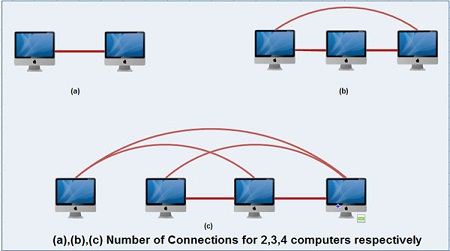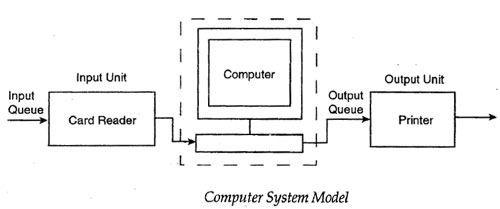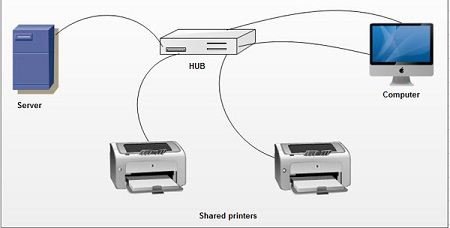In general, a computer network composed of one or more servers, workstations, network interface cards, active and passive hub, routers, bridges, gateways, modem, software components like network operating systems, and other application software. The following components widely used for the construction of networks. [Read more…] about Computer Network Components
What is Shared Ethernet Networks?
Shared Ethernet Networks implementing technical standard access to physical media by the IEEE 802.3 working group under the name MAC access (Medium Access Control). MAC uses a general technique called random access. [Read more…] about What is Shared Ethernet Networks?
What are the physical layer interfaces?
The physical layer represents the first level of the hierarchy of the reference model. This level is responsible for transporting the bits on physical media varied. To access a support, use an access interface. [Read more…] about What are the physical layer interfaces?
What is Optical Switches?
The Optical Switches are used to connect optical links between them. At incoming optical fibers correspond outgoing optical fibers. If the switch uses an electrical part, the switch is said opto electronics and not only optical. These switches are based on the interconnection of switching elements, that is to say, switches which have two input gates and two output ports as shown in Figure. Connected in series, these elementary switches allow making great switches. The design of these devices, however, poses many problems. [Read more…] about What is Optical Switches?
What is Wavelength Routing Networks?
The idea at the basis of the wavelength routing network consists of maximum reuse the same wavelengths. The figure illustrates a node of a routing network wherein wavelengths of the same wavelength are used repeatedly. [Read more…] about What is Wavelength Routing Networks?
What is a Distributed Computing System? – Definition
A Distributed computing is a model of computation that is firmly related to Distributed Systems, refers to as multiple computer systems located at different places linked together over a network and use to solve higher level computation without having to use an expensive supercomputer. Distributed system is called, When collection of various computers seems a single coherent system to its client, then it is called distributed system.
[Read more…] about What is a Distributed Computing System? – Definition
What is Broadcast Network?
Broadcast: Any form of communication in which a single sender transmits messages to many receivers at once, the most familiar examples being the television and public radio systems. The opposite of broadcast is POINT-TO-POINT or narrowcast communication, between just a single transmitter and a single receiver – a telephone conversation for example. When such a multiple connection is made via a network cable as opposed to wireless, such communication is often called MULTIPOINT, as opposed to a point-to-point or UNICAST. Communication channel is shared by all the machines on the network in broadcast network.
[Read more…] about What is Broadcast Network?
What is bps (bits per second)?
The acronym bps stands for bits per second, which is a measurement of how fast information (data) travels between two devices. When two modems converse via the telephone line, the speed of modem communications is measured in bps. (When people talk about modems, they often use the word “baud” to mean the same thing as bps, though technically the two terms are not synonymous. [Read more…] about What is bps (bits per second)?
What is baud rate?
baud, baud rate A baud is the number of signaling elements per second sent by a communications device such as a modem, In theory, a modem with a high baud rate means fast transmission. The baud rate is therefore equal to the bit rate only if each signal element represents one bit of information. [Read more…] about What is baud rate?
What is Internetworks
Availability of different operating systems, hardware platforms and the geographical dispersion of the computing resources necessitated the need of networking in such a manner that computers of all sizes can communicate with each other, regardless of the vendor, the operating system, the hardware platform, or geographical proximity. Therefore, we may say that internetworking is a scheme for interconnecting multiple networks of dissimilar technologies. To interconnect multiple networks of dissimilar technologies use both additional hardware and software. This additional hardware is positioned between networks and software on each attached computer. Thus, system of interconnected networks is called an inter network or an Internet. [Read more…] about What is Internetworks
TCP/IP Encapsulation
TCP/IP encapsulate upper layers using headers for the purpose of exchanging control and status information about the progress of the communication because its protocols also engage in peer talk by encapsulating data with protocol headers before submitting it to the underlying layer for subsequent delivery to the network. The data communication using TCP/IP and Ethernet as it is passed down the layers by an application on node X to node Y across the network. [Read more…] about TCP/IP Encapsulation
Lan Operating Systems
A LAN Operating System, or Network Operating System (NOS), is software that provides the network with multi-user, multitasking capabilities. The operating system facilitates communications and resource sharing, thereby providing the basic framework for the operation of the LAN. The operating system consists of modules that are distributed throughout the LAN environment. Some NOS modules reside in servers, while other modules reside in the clients. [Read more…] about Lan Operating Systems
What is protocol? and its types – Definition
Protocol Definition: It is a digital language through which we communicate with others on the Internet. protocol meaning is that it a set of mutually accepted and implemented rules at both ends of the communications channel for the proper exchange of information. By adopting these rules, two devices can communicate with each other and can interchange information. We can’t even think of using the Internet without Protocols. Each protocol is defined in different terms and different use with unique name. Message travel from sender to receiver via a medium (The medium is the physical path over which a message travels) using a protocol. [Read more…] about What is protocol? and its types – Definition
Star Topologies – What is Star Topologies?
The distinguishing feature of star topology is that all nodes are joined at a single point, as shown in Figure. This single point is called as a central node, hub, or switch, to which all other devices are attached directly, generally via UTP or STP. This topology is frequently used for networks in which control of the network is located in the central node. This method is optimal when the bulk of communication is between the central and outlying nodes. If traffic is high between outlying nodes, an undue switching burden is placed on the central node. [Read more…] about Star Topologies – What is Star Topologies?
Ring Topologies – What is Ring Topologies?
The ring architecture is a distributed architecture, with minimal connectivity and a topology of two links connected to every node as shown in Figure and forms unbroken circular configuration. Figure shows a network laid out in a physical ring, or closed loop, configuration. Transmitted messages travel from node to node around the ring. Each node must be able to recognize its own address in order to accept messages. [Read more…] about Ring Topologies – What is Ring Topologies?
What is Bus Topology? Advantages and Disadvantages of Bus Network
Bus Topology is multipoint electrical circuits that can be implemented using coaxial cable, UTP, or STP. Data transmission is bidirectional, with the attached devices transmitting in both directions. While generally operating at a raw data rate of 10 Mbps, actual throughput is much less. [Read more…] about What is Bus Topology? Advantages and Disadvantages of Bus Network
Point-to-point Connections
The point-to-point scheme provides separate communication channels for each pair of computers. When more than two computers need to communicate with one another, the number of connections grows very quickly as number of computer increases. Above figure illustrates that two computers need only one connection, three computers need three connections and four computers need six connections. [Read more…] about Point-to-point Connections
[Read more…] about Point-to-point Connections
What is Metropolitan Area Network (MAN)? – Definition
The MAN network (Metropolitan Area Network) is a high-speed network (broadband) that covers larger geographic area such as city (tens of kilometers) or districts than local area network (LAN) but smaller than wide area network (WAN) and providing the ability to integrate multiple services through the transmission of data, voice, and video, on transmission media such as copper, fiber optics, and microwaves. [Read more…] about What is Metropolitan Area Network (MAN)? – Definition
Evolution of Computer Networks
The term computer networks resulted from the ‘combination of two major areas, namely computers and communications.  [Read more…] about Evolution of Computer Networks
[Read more…] about Evolution of Computer Networks
Need For Computer Networks
The term network is defined as a set of computers of different types, terminals, telephones, and other communication equipments, connected by data communication links, which allow the network components to work together. The network components may be located within a small area or spread over many remote locations. In any case, data communications hold the network together. [Read more…] about Need For Computer Networks
[Read more…] about Need For Computer Networks
Modem- Classification of Modems
Modem word came from the combination of two words modulator and demodulator. A modem is a hardware device that enables the computers to transmit data over cable or satellite connection.A modem converts signals between modulator and demodulator vice versa. The outgoing digital signals from a computer a modem can modulates to an analog signals and in the demodulation in reverse analog signal are converts back to a digital signal.The modems can be classified according to their characteristics as below: [Read more…] about Modem- Classification of Modems
Frequency Shift Keying (FSK)
In “frequency shift keying (FSK)”, the frequency of a sinusoidal carrier is shifted between two discrete values. One of these frequencies (f1) represents a binary “1” and the other value (f0) represents a binary “0”. The representation of digital data using FSK is as shown in Fig. Note that there is no change in the amplitude of the carrier. [Read more…] about Frequency Shift Keying (FSK)
Amplitude Shift Keying (ASK)
Amplitude Shift Keying (ASK) is the simplest type of digital CW modulation. Here the carrier is a sinewave of frequency fc. We can represent the carrier signal mathematically as follows: [Read more…] about Amplitude Shift Keying (ASK)
What is Switched Multimegabit Data Service (SMDS)? Advantages & Disadvantages of SMDS
The Multimegabit Data Switching Service (SMDS) is not a protocol, but rather a “metropolitan area service (MAN).” In essence, it is a method of transmitting ATM cells (Asynchronous Transfer Mode) through a shared bus. First used in 1992, it obtained its support when the Regional Bell Operating Companies (RBOC) and other local communication service providers (LEC) began to feel competitive pressure from long-distance communication companies (IXC) in local markets and considered that the best defense against competition was a high-speed data transmission system. SMDS, thanks to its relatively low cost and high-speed data switching service, seemed the perfect solution and many of the LECs in large metropolitan areas began offering the service. [Read more…] about What is Switched Multimegabit Data Service (SMDS)? Advantages & Disadvantages of SMDS
What is a Wide Area Network (WAN)? – Difference between WAN and LAN
In today’s modern telecommunications, the need to expand networks is rapidly growing. While a LAN can cover most communication and resource sharing needs within a campus or company, WAN connectivity allows users and organizations to take more significant advantage of services such as the Internet, e-commerce, and videoconferencing. [Read more…] about What is a Wide Area Network (WAN)? – Difference between WAN and LAN
What is LAN (Local Area Network) | Definition of LAN
What is lan: It is a privately-owned network and stands for local area network. A network is a group of computers and other devices connected so they can pass information back and forth. The local area network (LAN) is a network which is designed to operate over a small physical area such as an office, factory or a group of buildings up to a few kilometers in size. LANs very widely used in a variety of computers to share resources (e.g., printers) and exchange information. [Read more…] about What is LAN (Local Area Network) | Definition of LAN
Types of Transmission Technology
The transmission means, is that sending a signal from one location to another. Transmission technologies refer to the physical layer protocol such as modulation, demodulation, line coding, error control etc. The transmission technology can be categorized broadly into two types: [Read more…] about Types of Transmission Technology
What is Connectionless Service?
Connectionless service is a self-contained action and does not include establishment, maintenance and releasing a connection. [Read more…] about What is Connectionless Service?
What is Hybrid networks?
• Hybrid networks are the networks that are based on both peer-to-peer & client-server relationship.
• Hybrid networks incorporate the best features of workgroups in peer-to-peer networks with the performance, security and reliability of server-based networks.
• Hybrid networks still provide all of the centralized services of servers, but they also allow users to share and manage their own resources within the workgroup. [Read more…] about What is Hybrid networks?
What is Router | Definition of Router
What is router: Router is a network layer (Layer 3) of the OSI reference model device that means it can connect multiple computer networks via wired or wireless connections. Network router can receive, analyze, perform the traffic directing functions and forwards data packet from one network to its destination node. A router is a device that forwards packets between networks by processing the routing information included in the packet.
[Read more…] about What is Router | Definition of Router